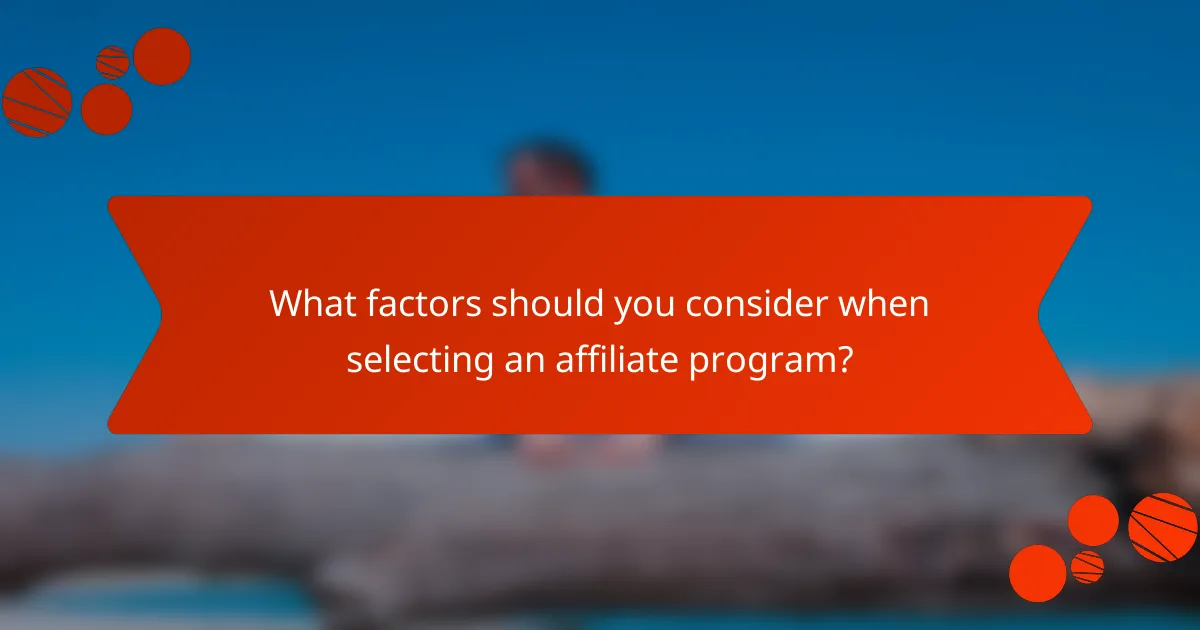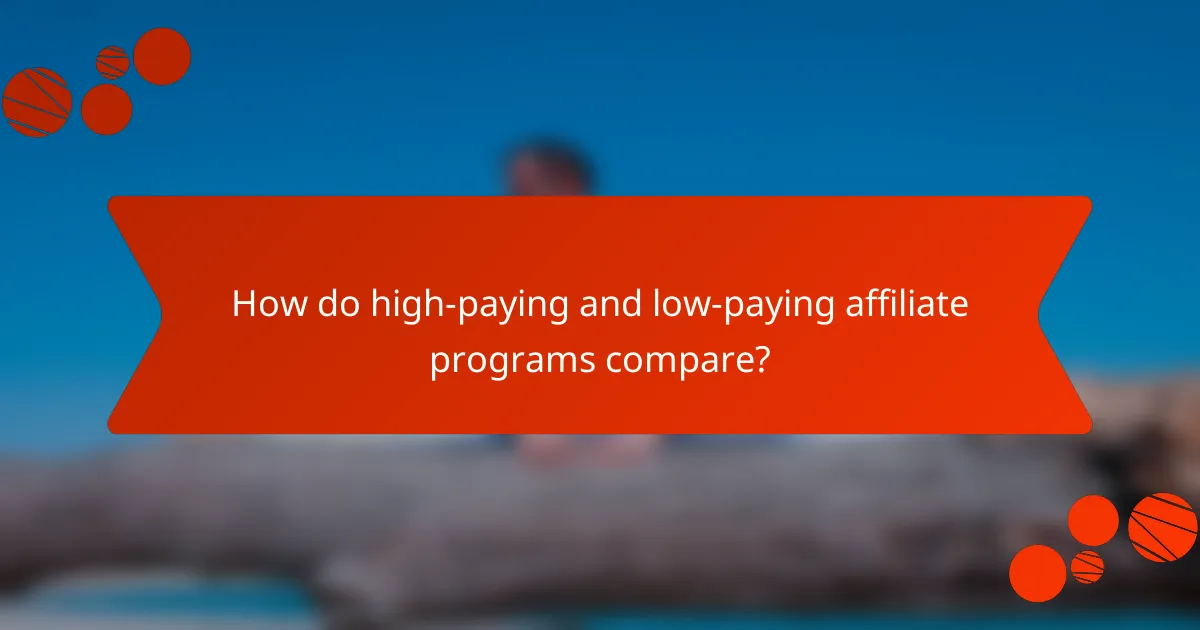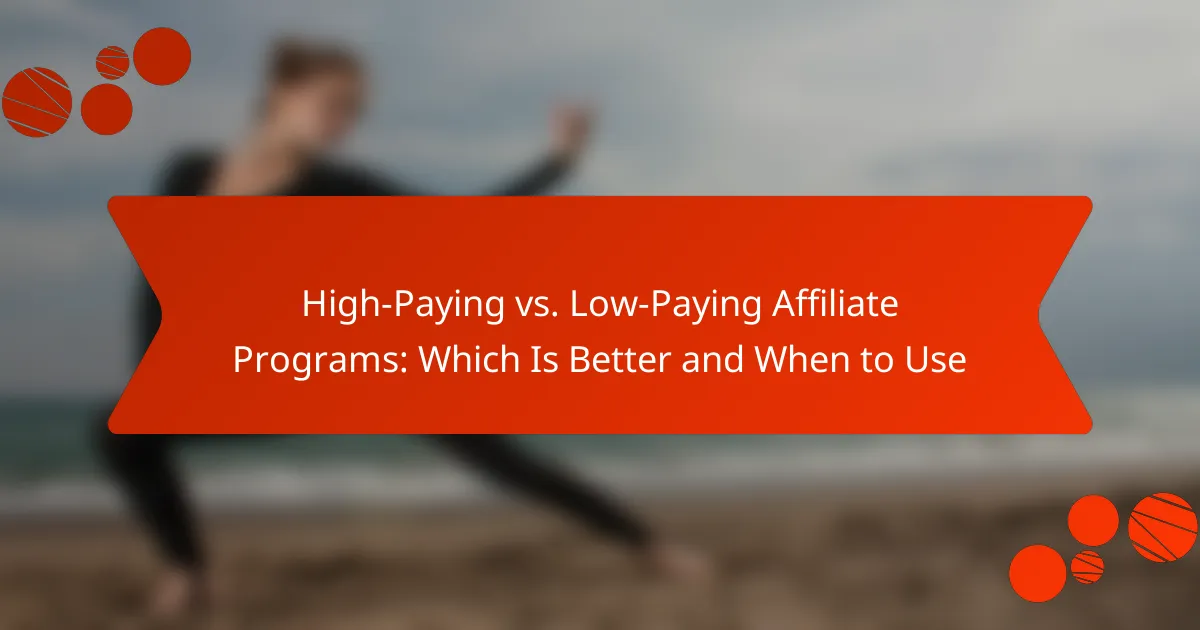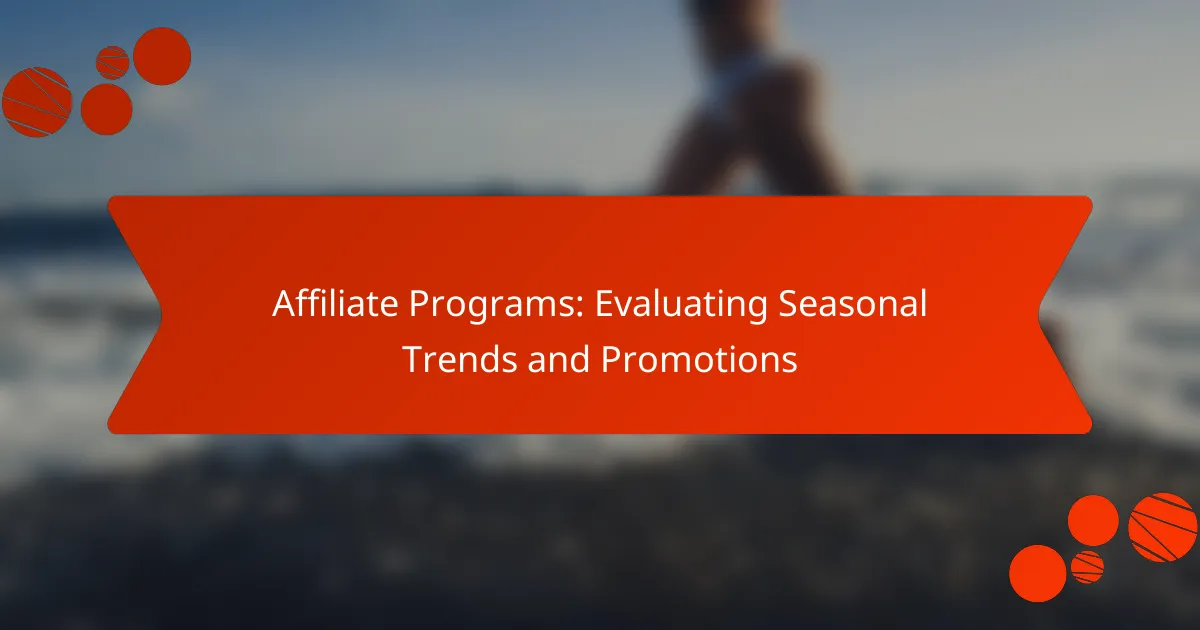When choosing between high-paying and low-paying affiliate programs, it’s essential to consider your goals and audience. High-paying programs can yield substantial earnings with higher commission rates, making them attractive for experienced marketers. Conversely, low-paying programs may offer easier entry points and are beneficial for those starting out or focusing on niche markets, allowing for audience growth and loyalty over time.

Which affiliate programs offer the highest payouts?
High-paying affiliate programs typically offer commissions ranging from 30% to 75% of the sale price, depending on the product or service. These programs can be lucrative for marketers who choose the right niche and understand their audience.
Amazon Associates
Amazon Associates is one of the most popular affiliate programs, offering commissions that range from 1% to 10% based on the product category. While the payouts may seem low compared to others, the vast selection of products can lead to high volume sales, making it a viable option for many affiliates.
Consider focusing on high-ticket items or seasonal products to maximize earnings. Keep in mind that Amazon has specific rules regarding cookie duration and payment thresholds, which can affect your overall revenue.
ClickBank
ClickBank is known for its high commission rates, often between 50% and 75%. This platform specializes in digital products, such as e-books and online courses, which typically have lower overhead costs, allowing for higher payouts.
When promoting ClickBank products, select items with a strong sales history and positive reviews to increase conversion rates. Be aware of the refund policies, as high refund rates can impact your earnings.
Shopify Affiliate Program
The Shopify Affiliate Program offers a commission of up to $2,000 for each new merchant referred, making it one of the highest-paying options available. This program is ideal for those with an audience interested in e-commerce and online business.
To succeed, create content that showcases the benefits of using Shopify, such as ease of use and scalability. Focus on targeting entrepreneurs and small business owners who are looking to start their online stores.
Bluehost Affiliate Program
Bluehost offers a flat fee of $65 for each referral, which can increase based on performance. This program is particularly appealing for bloggers and website creators who can recommend hosting services to their audience.
When promoting Bluehost, emphasize their reliable service and customer support. Providing tutorials or guides on setting up a website can enhance your credibility and lead to higher conversion rates.
Fiverr Affiliates
The Fiverr Affiliates program allows you to earn up to $150 for each new buyer referred, depending on the service purchased. This program is suitable for those targeting freelancers and small business owners who need various services.
To maximize your earnings, promote Fiverr through niche-specific content that highlights the platform’s diverse offerings. Use social proof and testimonials to build trust with your audience, encouraging them to make a purchase through your link.

What are the benefits of high-paying affiliate programs?
High-paying affiliate programs offer significant advantages, primarily through increased earnings and the potential for greater business growth. These programs typically feature higher commission rates, which can lead to more substantial revenue when promoting products or services.
Higher commission rates
High-paying affiliate programs generally provide commission rates that can range from 20% to over 50% of the sale price. This means that for every sale made through your referral, you earn a larger portion of the revenue compared to lower-paying programs. Choosing programs with higher rates can significantly enhance your overall earnings.
When selecting an affiliate program, look for those that offer competitive commission structures. Programs that provide tiered commissions based on performance can also incentivize you to drive more sales, further increasing your income potential.
Increased revenue potential
The revenue potential of high-paying affiliate programs is often much greater than that of their low-paying counterparts. With higher commissions, even a few sales can lead to substantial earnings. For instance, promoting a product priced at $500 with a 30% commission results in $150 per sale, compared to a $50 product with a 10% commission yielding only $5.
To maximize revenue, focus on promoting products that not only offer high commissions but also have a strong market demand. Researching trends and consumer interests can help you choose the right products to promote, ensuring you capitalize on lucrative opportunities.
Attracting premium audiences
High-paying affiliate programs often attract premium audiences who are willing to invest in quality products or services. These consumers typically have higher purchasing power and are more likely to convert, leading to better results for your affiliate marketing efforts. By targeting these audiences, you can build a more profitable affiliate business.
To effectively reach premium audiences, tailor your marketing strategies to highlight the value and benefits of the products you promote. Use high-quality content and targeted advertising to engage these consumers, ensuring your messaging resonates with their needs and preferences.

When should you choose low-paying affiliate programs?
Low-paying affiliate programs can be advantageous in specific scenarios, particularly when you’re starting out or targeting niche markets. They often provide easier entry points and can help build a loyal audience over time.
Entry-level affiliate marketing
For beginners in affiliate marketing, low-paying programs are often more accessible. These programs typically have less stringent requirements and can be a great way to learn the ropes without significant financial pressure. Starting with lower commissions allows you to focus on developing your marketing skills and understanding your audience.
Consider programs that offer a flat commission structure, as they can simplify your earnings tracking. For instance, earning $5 per sale might seem low, but if you can generate hundreds of sales, the cumulative income can be substantial.
Niche markets with high conversion rates
In niche markets where products have high conversion rates, low-paying affiliate programs can still be profitable. Even with lower commissions, the volume of sales can lead to significant earnings. For example, promoting a specialized product that resonates well with a targeted audience can result in a higher conversion rate than a broader market with higher commissions.
Focus on products that solve specific problems for your audience. If you can effectively communicate the value of these products, you may find that even modest commissions can add up quickly.
Building brand trust and authority
Participating in low-paying affiliate programs can help establish your brand as a trusted authority in your niche. By promoting products that align with your content and values, you can build credibility with your audience. This trust can lead to higher engagement and loyalty over time.
Choose programs that reflect your brand’s mission and values. For instance, if you run a health blog, promoting low-cost health supplements can enhance your reputation as a reliable source of information. This strategy can pay off in the long run, as a trusted brand often sees increased traffic and conversions.

What factors should you consider when selecting an affiliate program?
When selecting an affiliate program, consider factors such as commission structure, product relevance to your audience, and payment terms. These elements can significantly impact your earnings and the effectiveness of your marketing efforts.
Commission structure
The commission structure of an affiliate program determines how much you earn per sale or action. Programs may offer a flat rate per sale, a percentage of the sale, or tiered commissions that increase with performance. For example, a program might pay 5% for the first $1,000 in sales and 10% for sales beyond that threshold.
Evaluate whether the commission rates align with your marketing strategy and audience. High-paying programs can be lucrative but may require more effort to convert sales, while lower-paying options might be easier to promote if they resonate with your audience.
Product relevance to audience
Choosing products that are relevant to your audience is crucial for successful affiliate marketing. If your audience finds the products useful or appealing, they are more likely to make a purchase. For instance, a tech blog should promote gadgets or software rather than unrelated items like fashion accessories.
Consider conducting surveys or analyzing your audience’s preferences to identify products that will resonate. Promoting relevant products not only boosts conversion rates but also enhances your credibility as an affiliate marketer.
Payment terms and frequency
Payment terms and frequency dictate how and when you receive your earnings from an affiliate program. Common payment methods include direct bank transfers, PayPal, or checks, and payment frequencies can range from weekly to monthly. Understanding these terms helps you manage your cash flow effectively.
Look for programs that offer reliable payment schedules and low payout thresholds. For example, a program that pays out once you reach $50 is more accessible than one requiring $200. Ensure you read the fine print regarding any fees associated with payment methods to avoid unexpected costs.

How do high-paying and low-paying affiliate programs compare?
High-paying and low-paying affiliate programs differ significantly in terms of revenue potential, marketing strategies, and target audiences. Choosing between them depends on your goals, resources, and the niche you are operating in.
Revenue potential
High-paying affiliate programs typically offer commissions that can range from 20% to 50% or more per sale, making them attractive for affiliates looking to maximize earnings. In contrast, low-paying programs often provide smaller commissions, usually between 5% to 15%, which may require higher sales volumes to achieve similar revenue. For instance, promoting a high-ticket item can yield substantial returns with fewer sales compared to a low-ticket item that requires numerous transactions to reach the same income level.
Marketing strategies
Marketing strategies for high-paying affiliate programs often focus on high-quality content and targeted advertising to attract buyers willing to invest more. This may include in-depth product reviews, webinars, or exclusive promotions. Low-paying affiliate programs, on the other hand, may benefit from broader outreach methods such as social media marketing or email campaigns aimed at generating higher traffic volumes, as the lower commissions necessitate a larger audience to convert effectively.
Target audience differences
High-paying affiliate programs generally target a niche audience that is more discerning and willing to spend on premium products or services. Understanding the specific needs and preferences of this audience is crucial for successful marketing. Conversely, low-paying affiliate programs often appeal to a wider audience looking for budget-friendly options, which means affiliates must cater to a more diverse set of interests and price sensitivities to drive conversions.

What are the risks of high-paying affiliate programs?
High-paying affiliate programs can offer substantial commissions, but they come with significant risks that affiliates must consider. These risks include increased competition, potential for lower conversion rates, and the possibility of stricter regulations.
Higher competition
High-paying affiliate programs often attract numerous marketers, leading to intense competition. This saturation can make it challenging for new affiliates to gain visibility and drive traffic to their offers.
To succeed in a competitive landscape, affiliates should focus on niche markets or unique selling propositions. Creating high-quality content and utilizing targeted advertising can help differentiate your offerings from others in the same space.
Lower conversion rates
While high commissions are appealing, they may correlate with lower conversion rates. This can occur if the products are overpriced or if the target audience is not adequately aligned with the offer.
Affiliates should analyze conversion metrics and consider promoting products with a balance of competitive pricing and quality. Testing different marketing strategies can also help identify the most effective approaches for boosting conversions.
Stricter regulations
High-paying affiliate programs may be subject to more stringent regulations, especially in industries like finance or health. Affiliates must ensure compliance with advertising standards and disclosure requirements to avoid penalties.
Staying informed about relevant laws and guidelines is crucial. Affiliates should consider consulting legal resources or industry experts to navigate complex regulations effectively.



